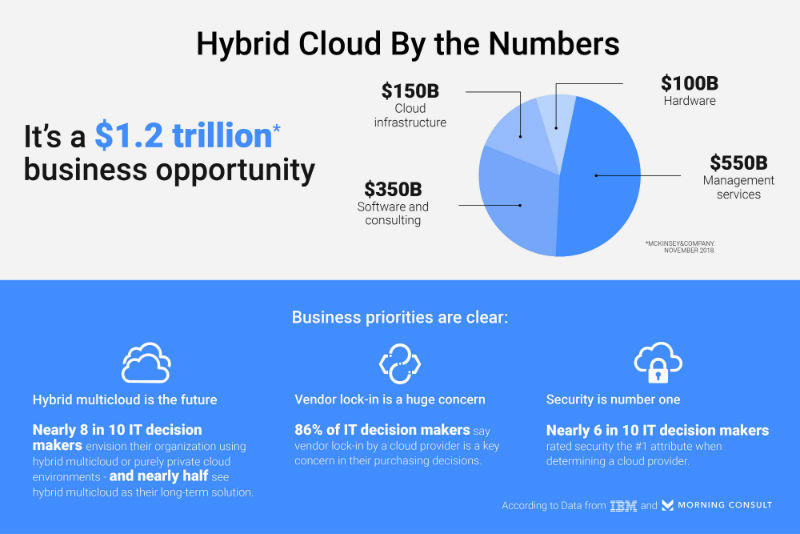Hybrid Multicloud
How a Hybrid Multicloud Strategy Can Overcome the Cloud Paradox
November 5, 2019 | Written by: Jim Comfort
Categorized: Hybrid Multicloud | IBM Cloud
Share this post:
 Public clouds have a lot to offer. Public clouds bring about agility, elasticity, and speed, which make a company’s IT shop become a lot more responsive to the needs of its business. By shifting workloads to the cloud, businesses can make great strides in reducing costs and boosting productivity. This allows them to focus on their core operations and more quickly pivot to new market opportunities.
Public clouds have a lot to offer. Public clouds bring about agility, elasticity, and speed, which make a company’s IT shop become a lot more responsive to the needs of its business. By shifting workloads to the cloud, businesses can make great strides in reducing costs and boosting productivity. This allows them to focus on their core operations and more quickly pivot to new market opportunities.
But, as exciting as public clouds are, businesses that rely on them inevitably run into a paradox: more and more of their data fall hostage to one cloud. Fear of vendor lock-in has quickly become a widespread concern. A study recently published by Morning Consult shows that 86% of IT decision-makers say that vendor lock-in by a cloud provider is a key concern in their purchasing decision.
Vendor lock-in is about more than just not being able to move to a different vendor. With each cloud choice that a company makes, comes a set of assumptions around everything from the developer tooling to the application capabilities they use. By over-relying on one public cloud, companies can place themselves on a set path and find it difficult to change developers’ habits over time.
A public cloud-only strategy presents other challenges. Companies have unique needs around their data and workloads that public clouds alone cannot satisfy. This is especially true of companies operating in highly regulated industries that need to address specific concerns related to compliance and data protection.
Security is a major concern as well. In fact, security is by far the most important attribute when determining a cloud provider, with nearly 6 in 10 IT decision-makers ranking it #1 among tested factors, according to data provided by Morning Consult. This, in part, explains why the vast majority of the world’s workloads remain in private data centers.
The benefits of hybrid multicloud: freedom and flexibility
When it comes to cloud, companies are truly on a journey. They need help crafting strategies that are unique to the environment they live in, the challenges they face, and the opportunities that will determine their future.
The world is messy and uncertain. Competition, market forces, tougher regulations, geopolitics, constant shifts in consumer demands and expectations—all of these reasons, among many others, mean that companies need to overcome the cloud paradox so they can be free to make critical decisions about the future of their IT infrastructure.
 What businesses need, now more than ever, is the freedom to securely deploy, run and manage their data and apps on the cloud of their choice—without running the risk of being locked in.
What businesses need, now more than ever, is the freedom to securely deploy, run and manage their data and apps on the cloud of their choice—without running the risk of being locked in.
This is exactly the value that a hybrid multicloud approach bring to large businesses. It gives them the freedom and flexibility to host their own software one day, move that same setup to a cloud provider the next and still have the freedom to change cloud providers down the road.
In addition, a hybrid multicloud approach makes it easier for companies to adopt common management and software development capabilities that cut across all of the places where they’re doing business—whether it’s in a public cloud, or a private cloud, or on-premises. This is especially important given the fact that computing today is done in so many different places.
A hybrid multicloud approach also brings all of the benefits of a public cloud to other parts of a company’s IT environment. It allows companies to gain visibility and control over their entire infrastructure and, in turn, do business and bring their innovations out into the world in a much more secure and efficient manner.
A $1.2 trillion opportunity that will reorder the industry
To a large extent, we already live in hybrid multicloud world. 94% of enterprises today are operating in de facto hybrid environments with a mix of public cloud, private cloud, traditional IT, and countless SaaS applications. And, 67% are using a mix of multiple cloud vendors, with different tools and management systems for each.
 There are reasons to believe that hybrid multicloud is swiftly becoming the dominant force driving change in the industry. In the long-term, nearly 8 in 10 IT decision-makers envision their organization using hybrid multicloud or purely private cloud environments, with nearly half viewing hybrid multicloud as their long-term solution.
There are reasons to believe that hybrid multicloud is swiftly becoming the dominant force driving change in the industry. In the long-term, nearly 8 in 10 IT decision-makers envision their organization using hybrid multicloud or purely private cloud environments, with nearly half viewing hybrid multicloud as their long-term solution.
The shift to hybrid multicloud is nowhere more apparent than in the market opportunity it has created. McKinsey & Company has estimated hybrid, multicloud to be a $1.2 trillion market opportunity by 2022, comprised of hardware ($100b), cloud infrastructure ($150b), software ($350b), and consulting and management services ($550b).
Hybrid multicloud is a massive opportunity that will have profound effects on the industry as a whole. For businesses, the stakes are high. Every company is, in effect, becoming a technology company. Information technology has gotten to the point where it’s almost impossible to distinguish between the business strategy and IT strategy of any successful organization.
That said, the growing importance of hybrid multicloud is a unique chance for companies to free themselves of vendor lock-in and, more importantly, to unleash the full potential of the cloud.

General Manager, Multicloud Offerings, IBM Cloud
Q&A: IBM’s Landmark Acquisition of Red Hat
Arvind Krishna, Senior Vice President, IBM Cloud & Cognitive Software and Paul Cormier, Red Hat Executive Vice President and President, Products and Technologies discuss the landmark acquisition. How will IBM and Red Hat benefit from joining forces? Paul: Red Hat is an enterprise software company with an open source development model. A fundamental tenet […]
Intelligent Tech Turns the Tide on Trafficking
Human trafficking and modern slavery are on the rise around the world. In its latest report, The International Labour Organisation found there are approximately 40.3 million victims of modern slavery. In the UK alone, authorities have seen the number of incidents reported rise by 36 percent in a year, with the Home Office estimating a […]
Re-Inventing Care in the Digital Era
At some point in our lives, nearly all of us will provide care for a loved one. When that person is elderly or disabled, the experience can be overwhelming. About 18 months ago, I was approached by healthcare professional Helen Dempster who, after being a caregiver for her grandfather, had an idea for how to […]


